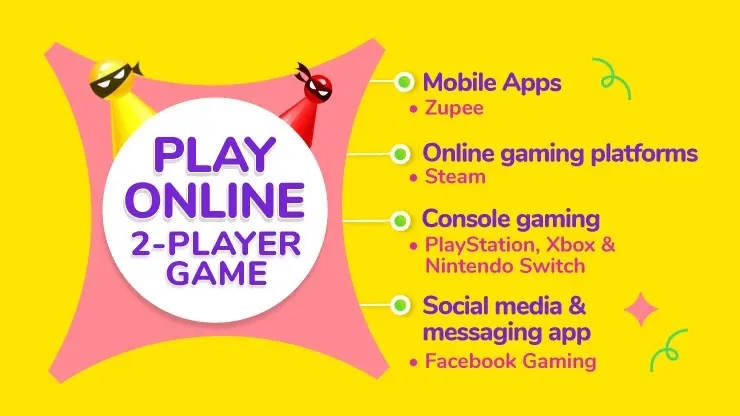The Evolving Landscape Of Two-Player Online Gaming In 2025: A Look At The Future Of Shared Experiences
The Evolving Landscape of Two-Player Online Gaming in 2025: A Look at the Future of Shared Experiences
Related Articles: The Evolving Landscape of Two-Player Online Gaming in 2025: A Look at the Future of Shared Experiences
Introduction
In this auspicious occasion, we are delighted to delve into the intriguing topic related to The Evolving Landscape of Two-Player Online Gaming in 2025: A Look at the Future of Shared Experiences. Let’s weave interesting information and offer fresh perspectives to the readers.
Table of Content
The Evolving Landscape of Two-Player Online Gaming in 2025: A Look at the Future of Shared Experiences

The realm of online gaming is constantly evolving, with advancements in technology and shifting player preferences constantly reshaping the landscape. One area experiencing a notable transformation is two-player gaming across different computers, a segment poised to become even more engaging and immersive in 2025. This article delves into the anticipated developments in this domain, exploring the technological innovations, evolving game genres, and potential benefits that will define the future of shared gaming experiences.
Technological Advancements Shaping the Future
The technological advancements driving this evolution are multifaceted and interconnected.
1. Cloud Gaming: A Seamless Gateway to Shared Experiences: Cloud gaming platforms are predicted to become even more ubiquitous in 2025, offering players the ability to access and play games on any device with an internet connection. This accessibility will significantly broaden the reach of two-player games, eliminating the need for both players to own the same console or powerful hardware. The cloud will act as a common platform, allowing players to connect and enjoy games together regardless of their physical location or device capabilities.
2. Enhanced Networking: Bridging the Distance: Advancements in networking technology will play a crucial role in facilitating smooth and seamless gameplay experiences for two players across different computers. Lower latency, improved bandwidth, and more robust server infrastructure will ensure a more responsive and immersive experience, minimizing lag and enhancing the overall enjoyment of cooperative and competitive gameplay.
3. Virtual and Augmented Reality: A New Dimension of Shared Play: Virtual and augmented reality (VR/AR) technologies are expected to play an increasingly significant role in two-player gaming. VR headsets will allow players to immerse themselves in shared virtual worlds, fostering a heightened sense of presence and interaction. AR, on the other hand, will overlay digital elements onto the real world, creating opportunities for unique and collaborative experiences that blend the physical and virtual.
4. Artificial Intelligence: Enhancing Player Interaction and Immersion: AI will continue to play a crucial role in enhancing the overall gaming experience. In two-player games, AI can be used to create more dynamic and responsive environments, generate challenging opponents, and even act as a virtual teammate or opponent, enhancing the depth and complexity of gameplay.
5. Cross-Platform Compatibility: Breaking Down Barriers: The increasing prevalence of cross-platform compatibility will further enhance the accessibility and reach of two-player games. Players on different consoles or operating systems will be able to connect and play together, expanding the potential player pool and fostering a more inclusive gaming community.
Evolving Game Genres and Play Styles
The evolution of technology will inevitably lead to the emergence of new game genres and play styles tailored to the unique capabilities of two-player online games across different computers.
1. Collaborative Puzzle Games: The collaborative nature of these games will be amplified by the ability to share screens and communicate in real-time. Players will be able to work together to solve puzzles, overcome challenges, and progress through the game, fostering a sense of teamwork and shared accomplishment.
2. Competitive Multiplayer Games: The competitive nature of these games will be heightened by the ability to play against each other directly, regardless of physical location. Players will be able to test their skills against each other in a variety of game modes, from traditional head-to-head matches to more complex team-based competitions.
3. Cooperative Adventure Games: These games will offer players the opportunity to explore vast virtual worlds, solve intricate mysteries, and overcome challenging obstacles together. The ability to communicate and coordinate strategies in real-time will be crucial for success in these games, fostering a sense of camaraderie and shared achievement.
4. Asymmetrical Multiplayer Games: These games will feature unique gameplay mechanics for each player, creating a more dynamic and unpredictable experience. One player might control a powerful character, while the other might take on a more strategic or supportive role. This asymmetry will add an element of surprise and challenge to the gameplay, keeping players engaged and entertained.
5. Social and Casual Games: The rise of social and casual games will continue to offer players a more relaxed and accessible way to connect and play with friends. These games will often feature simple mechanics and intuitive controls, making them easy to pick up and play, even for players with limited gaming experience.
Benefits of Two-Player Online Gaming across Different Computers
The future of two-player gaming across different computers holds numerous benefits for players and the gaming industry as a whole:
1. Enhanced Social Interaction: Online gaming provides a platform for players to connect and interact with friends and family members who may be geographically dispersed. This fosters a sense of community and shared experience, bridging the gap between physical distance.
2. Improved Mental and Cognitive Skills: Many two-player games require strategic thinking, problem-solving, and quick decision-making, which can help to improve mental agility and cognitive skills.
3. Increased Accessibility and Inclusivity: The ability to play games across different computers removes barriers to entry, allowing players with varying hardware and software to enjoy the same games together. This fosters a more inclusive gaming environment, welcoming players of all backgrounds and abilities.
4. Fostering Creativity and Collaboration: Cooperative games, in particular, encourage players to work together, brainstorm ideas, and develop strategies. This fosters a sense of creativity and collaboration, which can be beneficial in both personal and professional settings.
5. Stress Relief and Relaxation: Playing games with friends or family can be a great way to de-stress and relax after a long day. The shared experience can provide a sense of camaraderie and enjoyment, helping to alleviate stress and promote well-being.
Frequently Asked Questions (FAQs) regarding Two-Player Online Games across Different Computers in 2025
1. Will I need a powerful computer to play two-player games across different computers in 2025?
The reliance on cloud gaming platforms will significantly reduce the need for powerful hardware. While having a good internet connection will be crucial, the actual hardware requirements for playing games will be less stringent, making gaming more accessible to a wider range of players.
2. How will latency be addressed in two-player games across different computers in 2025?
Advancements in networking technology, coupled with the optimization of game servers, will minimize latency issues. Lower latency will ensure smoother and more responsive gameplay, enhancing the overall experience.
3. What types of games will be available for two players across different computers in 2025?
The future of two-player online gaming is expected to be diverse, encompassing a wide range of genres, including collaborative puzzle games, competitive multiplayer games, cooperative adventure games, asymmetrical multiplayer games, and social and casual games.
4. How will players communicate and interact in two-player games across different computers in 2025?
Communication will be facilitated through a variety of methods, including voice chat, text chat, and in-game gestures. Some games may even utilize VR/AR technologies to enable more immersive and intuitive forms of interaction.
5. What are the potential risks of playing two-player games across different computers?
As with any online activity, there are potential risks associated with playing two-player games online. These risks include cyberbullying, online harassment, and data privacy concerns. It is important to be aware of these risks and take appropriate precautions to protect yourself and your data.
Tips for Enjoying Two-Player Online Games across Different Computers in 2025
1. Choose Games That Suit Your Play Style: Consider your preferences and those of your partner when selecting a game. Choose games that offer a balance of challenge, fun, and collaboration.
2. Communicate Clearly and Effectively: Effective communication is essential for a positive and enjoyable gaming experience. Use voice chat, text chat, or in-game gestures to coordinate strategies and share information.
3. Be Patient and Understanding: Lag and other technical issues can sometimes arise in online gaming. Be patient and understanding with your partner, and work together to overcome any challenges that may arise.
4. Take Breaks and Avoid Overplaying: While online gaming can be enjoyable, it is important to take breaks and avoid overplaying. Excessive gaming can lead to eye strain, fatigue, and other health problems.
5. Respect Your Partner and Other Players: Treat all players with respect, even if you are competing against them. Avoid using offensive language or engaging in disruptive behavior.
Conclusion
The future of two-player online gaming across different computers in 2025 is bright and filled with possibilities. Technological advancements, evolving game genres, and the increasing demand for shared experiences will drive the growth and evolution of this segment. As technology continues to evolve, players can expect more immersive, engaging, and accessible experiences, fostering a sense of community, collaboration, and shared enjoyment. The future of online gaming is one where the boundaries of distance are blurred, and the joy of shared experiences is amplified.








Closure
Thus, we hope this article has provided valuable insights into The Evolving Landscape of Two-Player Online Gaming in 2025: A Look at the Future of Shared Experiences. We thank you for taking the time to read this article. See you in our next article!